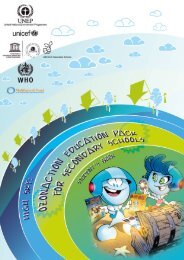Chapter 2. Progress towards the EFA goals - Unesco
Chapter 2. Progress towards the EFA goals - Unesco
Chapter 2. Progress towards the EFA goals - Unesco
You also want an ePaper? Increase the reach of your titles
YUMPU automatically turns print PDFs into web optimized ePapers that Google loves.
0<br />
0<br />
1<br />
CHAPTER 2<br />
2<br />
Education for All Global Monitoring Report<br />
On current<br />
trends,<br />
710 million adults<br />
will still lack<br />
basic literacy<br />
skills in 2015.<br />
3<strong>2.</strong> See note for<br />
Figure <strong>2.</strong>35 for how<br />
<strong>the</strong> literacy target has<br />
been measured.<br />
Figure <strong>2.</strong>33: Contrasting experiences in reducing illiteracy<br />
and <strong>the</strong> associated gender gap in four countries<br />
Age illiteracy profile in selected countries, by age group and gender, 2007<br />
Illiteracy rates (%)<br />
Illiteracy rates (%)<br />
100<br />
80<br />
60<br />
40<br />
20<br />
0<br />
100<br />
80<br />
60<br />
40<br />
20<br />
0<br />
75-84 65-74 55-64 45-54 35-44 25-34 15-24<br />
Age groups<br />
Bangladesh, male<br />
Bangladesh, female<br />
India, female<br />
India, male<br />
China, female<br />
China, male<br />
75-84 65-74 55-64 45-54 35-44 25-34 15-24<br />
Source: UIS database.<br />
Age groups<br />
Morocco, female<br />
Morocco, male<br />
indigenous-language speakers at 21% of adults<br />
compared with 4% for Spanish-speakers (Cueto<br />
et al., 2009). In South Asia, literacy gaps between<br />
lower and higher castes are pronounced. In Nepal,<br />
caste disparities are even larger than wealth<br />
and gender disparities (Nepal Ministry of Education<br />
and Sports and UNESCO Kathmandu, 2007).<br />
Disparities linked to location. Illiteracy tends to<br />
be higher in poorer regions, rural areas and slums.<br />
Regional disparities often mirror national poverty<br />
maps. For example, in Brazil some of <strong>the</strong> poorest<br />
states in <strong>the</strong> north-east – Alagoas, Maranhão,<br />
Paraíba and Piauí – have illiteracy levels twice as<br />
high as in <strong>the</strong> south-east (The George Washington<br />
University, 2006). In India, <strong>the</strong> regional spectrum<br />
extends from almost no illiteracy in <strong>the</strong> state<br />
of Mizoram to 50% illiteracy in Rajasthan (India<br />
Ministry of Human Resource Development and<br />
National University of Educational Planning and<br />
Administration, 2008). Rural areas often lag far<br />
behind urban areas (Kinsella and He, 2009).<br />
In Pakistan, urban literacy rates are twice as high<br />
as <strong>the</strong> rural average. Within urban areas illiteracy<br />
tends to be concentrated in informal settlements<br />
characterized by high levels of poverty (Pakistan<br />
Ministry of Education, 2008).<br />
None of <strong>the</strong>se disadvantages exists in isolation.<br />
Being female is a near-universal indicator for lower<br />
average literacy in many Arab states and most of<br />
South and West Asia, and sub-Saharan Africa. But<br />
gender disadvantage is compounded by poverty,<br />
location and ethnicity (Figure <strong>2.</strong>34). The wealth gap<br />
in <strong>the</strong> Philippines is particularly marked: women in<br />
<strong>the</strong> poorest households have literacy rates averaging<br />
65%, compared with over 96% for women in <strong>the</strong><br />
wealthiest households. In South Africa, white youth<br />
and adult women have near-universal literacy levels,<br />
compared with just 70% literacy among black<br />
women. In Mexico, women who only speak an<br />
indigenous language are about fifteen times less<br />
likely to be literate than women who only speak<br />
Spanish, and women lacking a knowledge of<br />
Spanish have literacy levels of just 5%. Literacy<br />
rates among Cambodian women living in Ratanakiri,<br />
a province dominated by indigenous hill tribes, are<br />
just over a third of those among women in <strong>the</strong><br />
capital, Phnom Penh.<br />
Prospects for achieving <strong>the</strong> 2015 target<br />
Current trends in adult literacy will leave <strong>the</strong> world<br />
short of <strong>the</strong> target set for 2015. 32 <strong>Progress</strong> has been<br />
so slow that <strong>the</strong> target is out of reach. Even in a<br />
best-case scenario, not enough children will enter<br />
adulthood literate over <strong>the</strong> next five years to halve<br />
<strong>the</strong> level of illiteracy. Continuing on <strong>the</strong> current trend<br />
will leave a very large gap with <strong>the</strong> Dakar promise.<br />
Projections provided for <strong>the</strong> <strong>EFA</strong> Global Monitoring<br />
Report 2010 give a ballpark estimate of <strong>the</strong> scale<br />
of shortfall: by 2015 <strong>the</strong> adult illiteracy rate will have<br />
fallen between 29% and 34% in <strong>the</strong> three regions<br />
with <strong>the</strong> highest rates. In o<strong>the</strong>r words, between half<br />
and two-thirds of <strong>the</strong> journey to <strong>the</strong> 50% illiteracy<br />
reduction target will have been completed.<br />
There is a very real human cost associated with<br />
<strong>the</strong> gap. On <strong>the</strong> current course, an estimated<br />
710 million adults – 13% of <strong>the</strong> world’s adults – will<br />
still lack basic literacy skills in 2015. Regional gaps<br />
between target and projected outcome are largest<br />
for South and West Asia, sub-Saharan Africa and<br />
<strong>the</strong> Arab States (Figure <strong>2.</strong>35). Failure to achieve <strong>the</strong><br />
Dakar adult literacy goal will translate into very<br />
large deficits for many countries. In India <strong>the</strong> target<br />
will be missed on current trends by around 81 million<br />
100
















